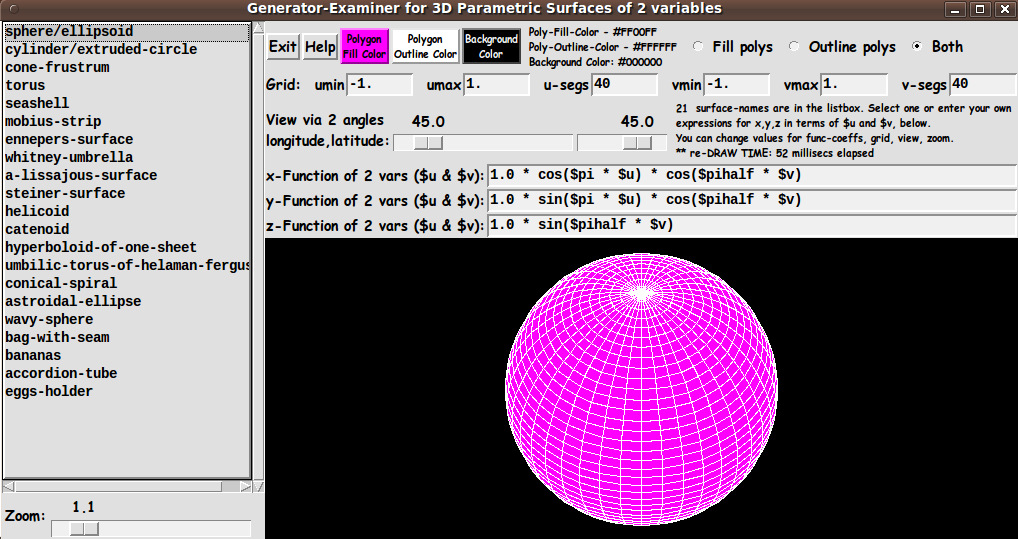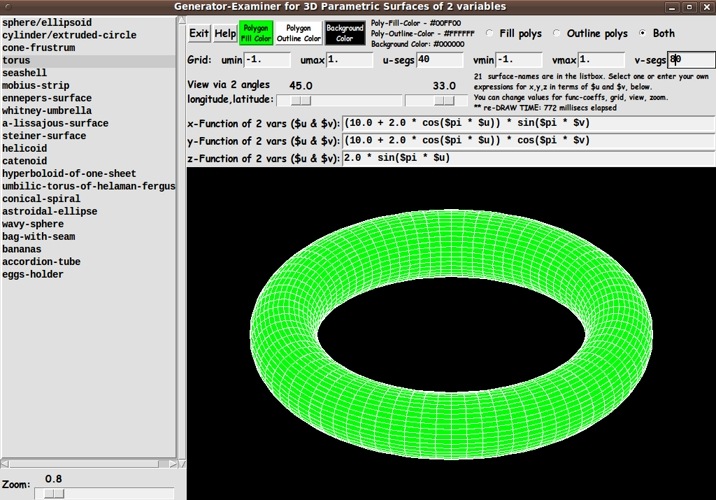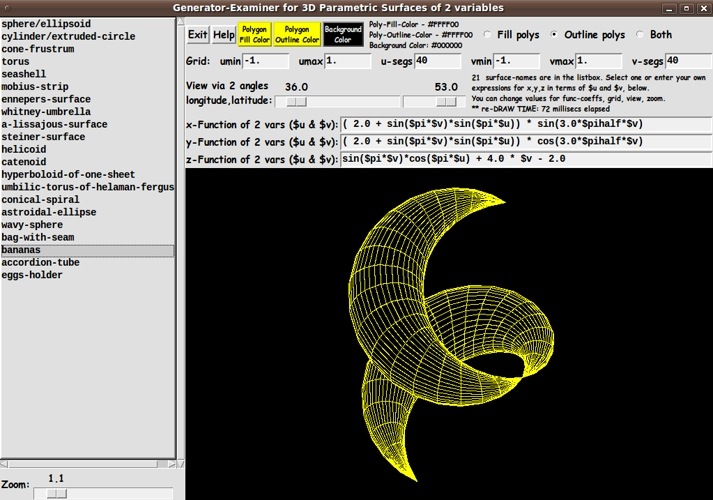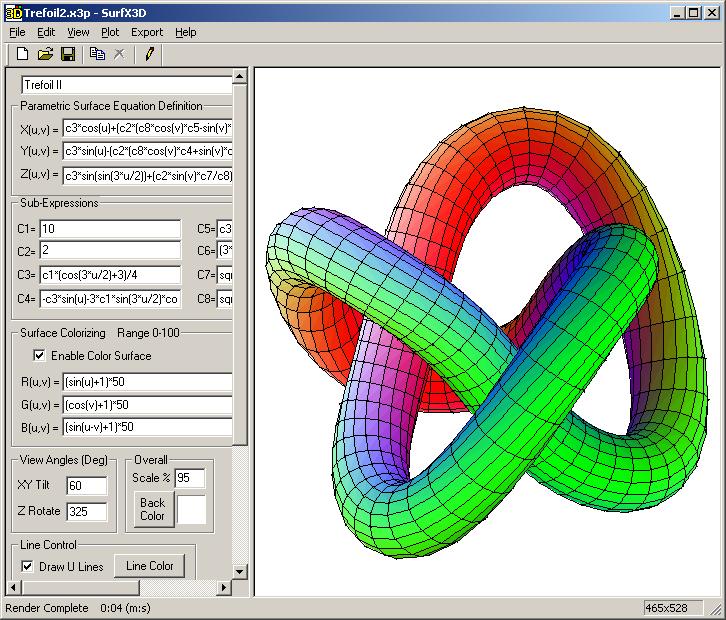|
INTRODUCTION to a
3D Examiner for Parametric Surfaces given by
3 functions of 2 Variables
On a page of this site titled
'A 3D Examiner for functions of 2 variables'
(originally posted at
wiki.tcl.tk),
I presented code for a Tk GUI that allows for examining surfaces
generated over a rectangular grid in the x-y plane ---
by determining z from a function f(x,y).
That was nice. In that script, I established a lot of procs
that I can use for other 3D viewers.
But the 'generator' part of that script only generates
function surfaces above a rectangular domain.
It is not suited to drawing-and-viewing spheres, ellipsoids, toruses,
cylinders, and other such surfaces that wrap around on themselves.
These are surfaces that are not 'single-valued' over a set of points
in a plane, and they do not 'cover' a rectangular domain.
However, these kinds of surfaces can be generated by 'parametric'
functions of the form x=f(u,v), y=g(u,v), z=h(u,v) where
u and v can be allowed to vary over a rectangular domain.
So I set about to modify the generator-and-examiner script for
surfaces given by f(x,y) so that it could generate and examine
parametric surfaces of the kind x=f(u,v), y=g(u,v), z=h(u,v).
I decided to stick with generating quadrilaterals
(rather than triangles) --- but over the u,v domain now,
instead of the x,y domain.
Using quadrilaterals would make it somewhat easier to re-use
some of the code in generating the surface.
One of the biggest changes that I had to make is in the method of
drawing the polygons --- in particular, handling the hiding of the
quadrilaterals at the back of the view.
In the script for functions f(x,y) generated over a rectangle in
the xy plane, I could simply start drawing from the 'far-away'
corner of the rectangular grid.
In this case of a rectangular domain in u,v parameter space, however,
I could not count on any corner of that rectangle having
polygons at the back of the view.
I needed to come up with a polygon sorting routine
according to 'z-depth'.
(Actually, because of the axes I chose relative to the
viewing screen, and because of the rotational transformation
I chose, I sorted according to 'x-depth'.)
Devising such a polygon-sort routine was just what I needed
for some future 3D projects I have in mind.
For example, on my 'bio' page --- titled 'uniquename' --- at
wiki.tcl.tk/28584, I have pointed out that I found
the 3D model viewing programs of MBS = Mark Stucky
(
3dviewer : A canvas only viewer of 3D data)
and GS = Gerard Soohaket
(
3D polyhedra with simple tk canvas) quite inspiring.
I want to devise a similar 3D viewer --- but with
enhanced 3D model import options and some other enhancements.
I want to support reading and examining models from
ASCII file formats such as Wavefront OBJ, Stereolithography STL,
Cyberware PLY, Geomview OFF, and a CAE(FEA)-like file format.
For that project, I will need a polygon sorting routine
according to 'z-depth'.
So this project to make a generator-and-examiner for
parametric surfaces would be a step in the right direction.
MY GOALS:
I decided to make a similar utility to my z=f(x,y) 3D surface generating and
examining utility --- including the following features.
1) ROTATION METHOD:
I would allow the user to specify latitude and longitude angles to specify
the view direction.
I would use Tk 'scale' widgets so that setting the 2 view angles can be done
quickly and redraw is almost immediate.
I would use '''button1-release bindings''' on the scales to cause
the redraw as soon as a scale change is complete.
(I may eventually add bindings to mouse events on the canvas,
like <Motion>, so that the view rotation can be done
even more quickly and conveniently.
This would be similar to rotate/zoom/pan controls that
Mark Stucky provided in a 3D model viewer that he published at
wiki.tcl.tk titled '3dviewer : A canvas only viewer of 3D data'.)
2) FUNCTION ENTRY:
Instead of having one entry field for the function f(x,y), I would have
3 entry fields --- for functions f(u,v), g(u,v), h(u,v).
And like in my f(x,y) utility, I would have a '''listbox of sample surfaces'''
(by name) on the left of the GUI.
Clicking on a line in the listbox puts a set
of functions in the 3 entry function fields.
This provides a way of providing some interesting functions that a user can
quickly try (and alter), instead of the user spending time trying to think of
parametric functions to try.
By using the listbox with scrollbars, an essentially unlimited number of
interesting surfaces could be supplied eventually.
3) COLOR CHOICES:
I would (again) allow color choices for the
- polygon fill
- polygon outline
- canvas background
from among 16 million colors, each.
4) DISPLAY OPTIONS:
I would (again) provide 3 radiobuttons by which polygon fill, outline
(wireframe display on the canvas background color), or both (fill and
outline) can be specified.
5) ZOOM OPTION:
I would (again) provide a 'zoom' Tk scale widget, by which the plot can
easily be resized, down or up --- to make sure the entire plot can be
seen on the canvas.
Like with the 2 scales for the longitude-latitude view angles, I would
use a button1-release binding on the zoom scale to cause the redraw as
soon as a scale change is complete.
6) MATH APPROACH:
I would (again) think of the 'fixed, global' coordinate axes oriented
as follows:
- positive z-axis is 'up'
- positive y-axis is 'to the right'
- positive x-axis is 'out of the screen'.
Based on that, I would let the 'longitudinal' ('yaw') view angle specify a
rotation around the z-axis and the 'latitudinal' ('pitch') view angle
specify a rotation around the y-axis.
Then rotations of the surface could be given by an Ry * Rz rotation matrix
product.
(We are avoiding 'roll' --- rotation around the x axis.
It is too disorienting. 'Roll' is for fighter jet simulations and
for emulating a modern cork-screw, turn-me-upside-down
roller coaster ride. After all ...
When we examine an object, like a motorcycle, we walk around it
and we may put our eyes somewhat above or below its middle ---
but we generally do not stand on our head to examine it.)
In addition to these rotational considerations, I needed to implement
a new procedure for sorting the polygons before drawing them.
It appeared that I should be able to use the '-command' option of the Tcl
'lsort' command --- by providing a 'compare' proc to compare 2 given
polygon IDs, according to a depth-measure.
SCREENSHOT of the GUI
In aiming to accomplish these goals, I ended up with the GUI seen in
the following image.
|






